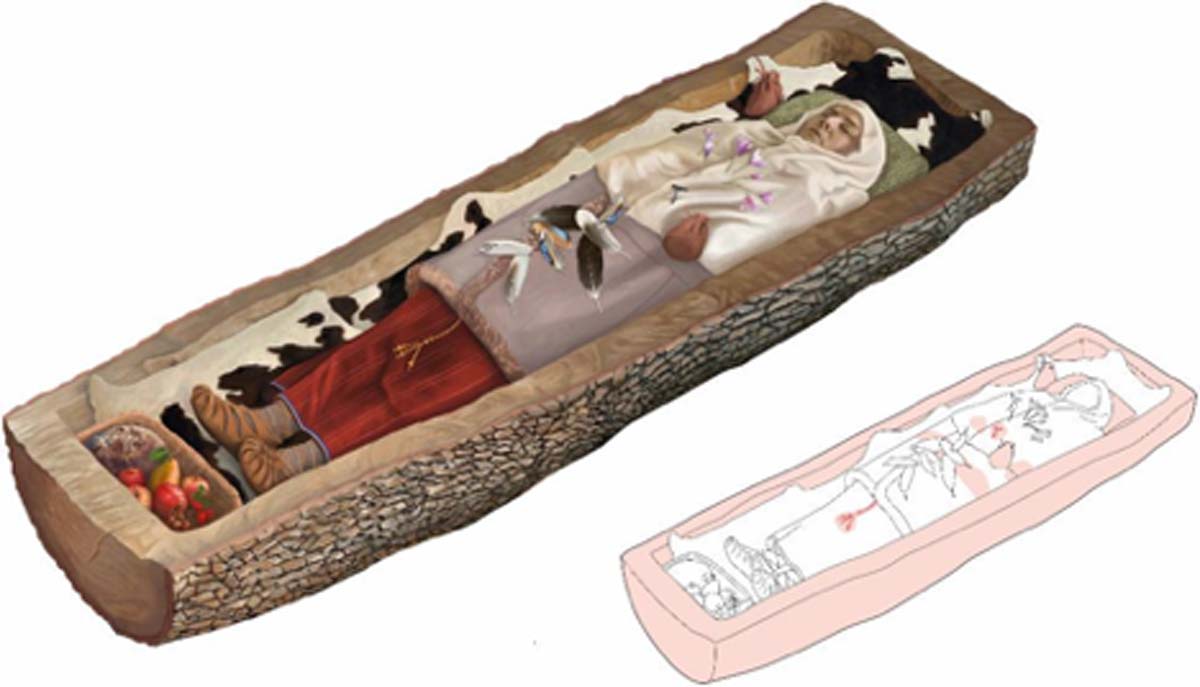Ancient Celtic Woman Emerges from Zurich Tree Coffin In Elegant Dress
2,200 years ago an Iron Age woman was buried in what is today Zurich and in her 'Tree Coffin’ she was dressed and draped for a ball…in the afterlife.
The ancient Celtic woman’s remains were excavated in March 2017 during a construction project at the Kern school complex in Aussersihl, a district in Zurich. According to the Office for Urban Development in Zurich, the woman was about 40 years old when she died and was found lying in a hollowed out tree wearing a “fine woolen dress and shawl, a sheepskin coat and a beautiful necklace strung with glass and amber beads.”
The archaeologists know that the “woman had probably performed little physical labor during her lifetime” and analysis of her teeth suggested she ate starchy or sweetened foods. What is more, fur and scraps of leather had been preserved in the grave and their assembly told specialists that “the woman wore probably a dress made of fine sheep's wool, about another woolen cloth and a coat of sheepskin.”
- Irish and Celtic Symbols: The True Meanings Behind Signs of Pride and Power
- Treasure Hunter Finds the First Celtic Chariot Burial in Wales, Rewrites Ancient History
- Farmer discovers huge hoard of more than 4,000 ancient Roman coins in Switzerland

The ancient corpse of a woman buried in a hollowed out tree in Zurich, Switzerland. Pictured are parts of her remains including her skull (top), as well as her jewelry (blue, bottom). (Zurich archaeology department)
The report on Stadt Zurich talks about the significance of the clasp on the woman’s bead necklace which is noted as being “unique in its form: it is fastened between two brooches (garment clips) and decorated with precious glass and amber beads.” The woman also wore bronze bracelets, a bronze belt chain with hanging pendants, and several iron clasps fastened her clothes together.

The Celtic the woman’s bead necklace. (Zurich archaeology department)
Log Flumes to the Afterlife
A press release by Stadt Zurich says that when the woman was originally found in March 2017 an isotope analysis of the woman's bones revealed that she had “been brought up in Zurich, likely in Limmat Valley.” The woman was found buried about 260 feet (80 meters) from the grave of a Celtic man who was discovered in 1903 during construction of the school’s new gym.
He had been buried with his sword, lance, and shield and in full warrior outfit - which identified him to the archaeologists as “a higher-level personality,” and this Live Science report detailing his discovery says the artifacts discovered with his weapons in the grave were “Scandinavian, Scottish and Irish in origin.” Because the man and woman had been buried within the same decade, and so close together, archaeologists consider it probable that they knew each other.

Because the man and woman had been buried within the same decade, and so close together, archaeologists consider it probable that they knew each other. (Zurich archaeology department)
Exploring Ancient Zurich
A 2004 SwissInfo article details the 19th century discovery of Neolithic and Bronze Age pile settlements situated on small islands and peninsulas submerged in Lake Zürich, and in 2004 traces of pre-Roman Celtic (La Tène culture) settlements were discovered on the Lindenhof hill in the historic center of Zurich. Lindenhof sits atop the remains of a glacier and the hilltop area consists of prehistoric, Roman, and medieval remains and it is listed as a Swiss heritage site of national significance.
- Buried Face Down with a Bag of Coins: Mysterious 17th Century Grave Discovered in Switzerland
- Exploring the Little Known History of Celtic Warriors in Egypt
- Global Warming Reveals Amazing Glacier Artifacts from Switzerland’s Ancient Past
This town-like Celtic settlement had been established by the first half of the 1st century BC; half a century before the Romans arrived, and in 1747 a 2nd-century Roman tombstone was discovered at the site, bearing the oldest attestation of Turīcum, the Roman era name of Zürich. Archaeologists believe the Alamanni settled in the area from the 5th century and that the Roman castle stood until the 7th century when the Ottonian dynasty reinforced it, but it was abandoned in the late 13th century and its stones were pillaged.
In 1798, the citizens of Zürich swore the oath to the constitution of the Helvetic Republic on the Lindenhof and in 1851 the Masonic Lodge 'Modestia cum Libertate' (1771) built a masonic lodge and temple on the southern end of the square.
Few archaeological remains of the pre-Roman Zürich era have been excavated because they are hidden beneath the densely built-up core of the modern city of Zürich. But the discovery of the Celtic man and woman suggest a world of ancient artifacts, people, and their stories might exist.

Jewelry buried with the Celtic woman. (Zurich archaeology department)
Top Image: Reconstruction of the Celtic woman’s burial in a tree. Source: Zurich archaeology department
By Ashley Cowie



















